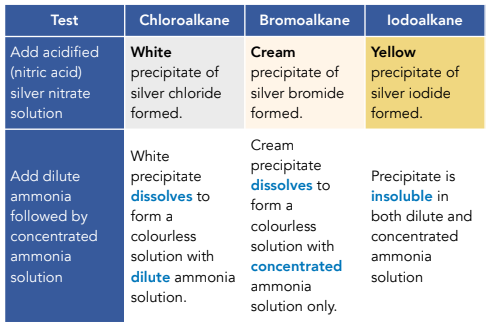Organic Analysis - Identification of Functional Groups (A-Level Chemistry)
Functional Group Identification Tests
Identification of functional groups by test-tube reactions
Simple test tube reactions can be used to determine the identify of specific functional groups.
Identifying Alkanes and Alkenes
Test: Add bromine water which is an orange solution
Result: If a double bond is present in the molecule, as there is in alkenes, the orange solution turns colourless. If there is no double bond, as in alkanes, there is no reaction, so the solution remains orange.
Explanation of reaction: Electrophilic addition reaction occurs.

Identifying Halogenoalkanes
Test:
- Warm with dilute sodium hydroxide solution.
- Add acidified (nitric acid) silver nitrate solution
- Add dilute ammonia solution
- Add concentrated ammonia solution
Results:

Explanation:
Nucleophilic substitution reaction occurs between the hydroxide ions from sodium hydroxide and the halogenoalkane.
The bond between the C and the halide is broken, releasing the halide ion.
Addition of acidified silver nitrate solution identifies the halide ion by the formation of different coloured precipitates as shown in the table.
Identifying Alcohols
Test: Warm with orange acidified potassium dichromate (VI) solution
Result: The orange solution turns green with primary and secondary alcohols, but stays orange (no reaction) with tertiary alcohols.
Explanation: Primary alcohols are oxidized to aldehydes, secondary alcohols are oxidized to ketones but tertiary alcohols are resistant to oxidation.

Identifying Aldehydes
Test 1 – Tollen’s Reagent: Warm aldehyde with Tollen’s reagent.
Result: Silver mirror is formed on the inside of the test tube.
Explanation: Tollen’s reagent is an alkaline solution containing diamine silver (I) ions ![]() dissolved in dilute ammonia.
dissolved in dilute ammonia.
The Ag+ ions are reduced to Ag(s) by the aldehyde. The aldehyde is oxidised to form a carboxylic acid.

Test 2 – Fehling’s Reagent: Warm aldehyde with Fehling’s solution which is a blue solution.
Result: The blue solution produces a brick red precipitate.
Explanation: Fehling’s solution is an alkaline solution of copper (II) ions ![]() dissolved in ammonia.
dissolved in ammonia.
The aldehyde is oxidised to make a carboxylic acid.
The blue Cu2+ ions are reduced to copper (1) oxide, which is a red precipitate.

Test 3 – Acidified ![]() Warm with acidified potassium dichromate solution
Warm with acidified potassium dichromate solution
Result: Solution turns from orange solution to green solution
Explanation: The aldehyde is oxidised to a carboxylic acid. The orange chromate (VI) ions are reduced to green chromium (III) ions.
Identifying Ketones
Test: Tollen’s solution, Fehling’s solution and acidified potassium chromate (VI) solution.
Result: No reaction occurs with Tollen’s solution, Fehling’s solution or potassium chromate (VI) solution
Explanation: Ketones are not able to reduce the Ag+ ions, the Cu2+ ions or the Cr6+ ions.
Identifying Carboxylic Acids
Test 1 – Limewater: Add a carbonate and bubble the gas produced through limewater.
Result: Effervescence is produced and bubbling the gas through limewater makes it turn cloudy.
Explanation: Carboxylic acids are strong enough acids to liberate carbon dioxide from carbonate ions.

Test 2 – Three Solutions: Warming with acidified potassium chromate (VI), Tollen’s solution, Fehling’s solution.
Result: No reaction occurs with with Tollen’s solution, Fehling’s solution or potassium chromate (VI) solution
Explanation: Carboxylic acids are not able to be oxidised further.
Organic Analysis is the process of identifying and determining the properties of organic compounds in A-Level Chemistry. It involves techniques such as spectroscopy, chromatography, and chemical reactions to determine the composition and structure of organic compounds.
Functional groups in A-Level Chemistry are specific groups of atoms within an organic compound that are responsible for its chemical properties and reactivity. Common functional groups include alcohols, aldehydes, ketones, carboxylic acids, and amines.
The identification of functional groups is important in A-Level Chemistry because it allows scientists to determine the properties and reactivity of an organic compound. Knowing the functional group present in a compound can also help predict its behavior in reactions, which is crucial for the development of new medicines and other products.
There are several methods for identifying functional groups in A-Level Chemistry, including:
Infrared Spectroscopy (IR): This technique involves using infrared light to detect the presence of functional groups based on their characteristic absorption patterns.
Nuclear Magnetic Resonance (NMR) Spectroscopy: This technique uses magnetic fields to determine the number and type of hydrogen atoms in a compound, which can be used to identify functional groups.
Chemical Reactions: This method involves performing specific chemical reactions on a compound to see how it reacts and identify the functional group present.
Some common functional groups in A-Level Chemistry include:
Alcohols: Contains an -OH functional group
Aldehydes: Contains a carbonyl (-C=O) functional group
Ketones: Contains a carbonyl (-C=O) functional group, but with the carbonyl located between two carbon atoms
Carboxylic Acids: Contains a carbonyl (-C=O) functional group and a hydroxyl (-OH) functional group
Amines: Contains a nitrogen atom bonded to one, two, or three hydrogen atoms
The presence of a functional group can greatly affect the reactivity of an organic compound in A-Level Chemistry. Different functional groups have different chemical properties and reactivity, which can influence the outcome of a reaction. For example, alcohols are typically more reactive than alkanes, and carboxylic acids are more reactive than aldehydes.
The identification of functional groups has several real-world applications in A-Level Chemistry, including:
Developing new medicines: Identifying functional groups in potential drug compounds can help predict their behavior in reactions and aid in the development of new medicines.
Quality control: Functional group analysis can be used to ensure the purity and composition of products, such as food additives and cosmetic ingredients.
Environmental monitoring: Functional group analysis can be used to monitor environmental pollution and the presence of contaminants in soil and water samples.






Still got a question? Leave a comment
Leave a comment